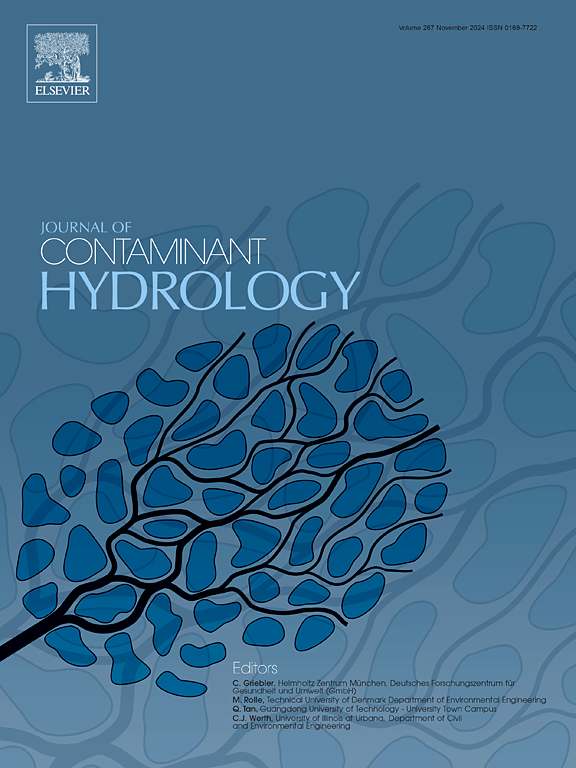结合扩展DLVO理论的种群平衡模型描述纳米塑料在水中的团聚
IF 4.4
3区 环境科学与生态学
Q2 ENVIRONMENTAL SCIENCES
引用次数: 0
摘要
纳米塑料颗粒(NPs)的团聚是水生系统中的一个自然过程,它在很大程度上受水成分和塑料聚合物类型的控制。当NPs聚集时,重力沉降增强,抑制了NPs在土壤和水体中的迁移,从而有利于NPs在沉积物和河床中的积累。本文将种群平衡方程(PBE)模型与扩展dlvo (XDLVO)理论相结合,建立了NPs集聚的模型。考虑到广泛的水成分和紫外线辐射的影响,提供了一个全面的分析。测量流体动力颗粒直径随时间的变化,并结合所研究系统的物理生化参数,从文献中提取,用于验证我们的计算。总的来说,该模型与实验测量结果非常吻合,并成功地捕获了水中化学和生物化合物的影响,以及阳光的影响。该模型有可能被整合到数学框架中来预测NP在地表水和地下水中的运移。此外,它还可以指导NP团聚提高去除率的高级过滤装置的设计和运行。本文章由计算机程序翻译,如有差异,请以英文原文为准。
Population balance modeling coupled with extended DLVO theory to describe nanoplastic agglomeration in water
Agglomeration of nanoplastic particles (NPs) is a natural process in aquatic systems and it is governed largely by water composition and plastic polymer type. When NPs agglomerate, gravitational settling is enhanced, inhibiting NPs migration in soil and water bodies and therefore favoring NPs accumulation in sediments and on riverbeds. In this paper, the agglomeration of NPs was modeled by coupling the population balance equation (PBE) model with the extended-DLVO (XDLVO) theory. A wide range of water compositions and the effects of UV radiation were considered to provide a comprehensive analysis. Measurements of the evolution of hydrodynamic particle diameter over time in conjunction with physico-biochemical parameters of the investigated systems were taken from the literature and used to validate our calculations. Overall, the model demonstrates strong agreement with experimental measurements and successfully captures the influence of chemical and biological compounds in water, as well as the effect of sunlight. The model has the potential to be integrated into mathematical frameworks to predict NP transport in surface water and groundwater. Additionally, it can guide the design and the operation of advanced filtration units where NP agglomeration could improve removal.
求助全文
通过发布文献求助,成功后即可免费获取论文全文。
去求助
来源期刊

Journal of contaminant hydrology
环境科学-地球科学综合
CiteScore
6.80
自引率
2.80%
发文量
129
审稿时长
68 days
期刊介绍:
The Journal of Contaminant Hydrology is an international journal publishing scientific articles pertaining to the contamination of subsurface water resources. Emphasis is placed on investigations of the physical, chemical, and biological processes influencing the behavior and fate of organic and inorganic contaminants in the unsaturated (vadose) and saturated (groundwater) zones, as well as at groundwater-surface water interfaces. The ecological impacts of contaminants transported both from and to aquifers are of interest. Articles on contamination of surface water only, without a link to groundwater, are out of the scope. Broad latitude is allowed in identifying contaminants of interest, and include legacy and emerging pollutants, nutrients, nanoparticles, pathogenic microorganisms (e.g., bacteria, viruses, protozoa), microplastics, and various constituents associated with energy production (e.g., methane, carbon dioxide, hydrogen sulfide).
The journal''s scope embraces a wide range of topics including: experimental investigations of contaminant sorption, diffusion, transformation, volatilization and transport in the surface and subsurface; characterization of soil and aquifer properties only as they influence contaminant behavior; development and testing of mathematical models of contaminant behaviour; innovative techniques for restoration of contaminated sites; development of new tools or techniques for monitoring the extent of soil and groundwater contamination; transformation of contaminants in the hyporheic zone; effects of contaminants traversing the hyporheic zone on surface water and groundwater ecosystems; subsurface carbon sequestration and/or turnover; and migration of fluids associated with energy production into groundwater.
 求助内容:
求助内容: 应助结果提醒方式:
应助结果提醒方式:


